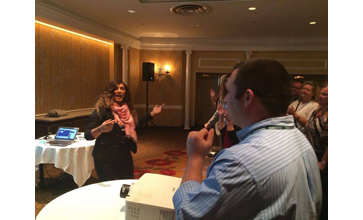Back in the New York Groove with Forrester, Part III: A Look Back at Highlights from #CXNYC
NICE’s Helen Cherry discusses the powerful trends
disrupting customer experience, at CXNYC 2016
(This post is the last in a series discussing Forrester’s CXNYC 2016 event. Read “Part I” and “Part II.”)
On the final day of the conference, NICE hosted a case study presentation, “Humana ‒ Tales of Innovation in Customer Experience.” To kick things off, NICE’s Helen Cherry discussed the seemingly omnipotent consumer technology brands that are today transforming customer expectations, and “changing the art of what’s possible.”
The conditioned consumer
According to Cherry, brands like Facebook have conditioned consumers to expect a personalized experience that is nevertheless respectful of their privacy. Brands like Apple have conditioned consumers to expect an experience that is easy to learn and elegant to use—and accessible from any number of devices, from any location. Brands like Amazon have conditioned consumers to expect real-time engagement, and instant delivery of the services or goods they desire. Ubiquitous connectivity is now the norm, and businesses that fail to adapt to this “new normal” will inevitably fail to stand out from the pack, if they survive at all.
When it comes to delivering the perfect customer experience, Cherry cited the findings of our recent survey with BCG, which found CX programs to be most successful when they met the following expectations for their customers:
- The frontline representative already knows what the customer needs, and provides them with an immediate solution (cited by 49% of respondents).
- The issue is resolved immediately (51%).
- The representative knows what the customer has already done via self-service channels (42%).
- The customer’s needs are answered proactively (40%).
- The customer’s information and actions are forwarded from department to department as needed (42%).
To achieve these ends, Cherry cited customer journey analytics as a key capability for empowering CX professionals. By capturing valuable customer data from every interaction across the customer journey, and translating those insights into actionable data, organizations can improve their routines and protocols to ensure customers remain loyal, while using internal resources in the most efficient manner possible. The sequence is demonstrated thusly:
Building a customer-centric culture
A Fortune 100 company, Humana is a major U.S.-based health insurance provider, operating in a highly regulated industry that has seen more than its share of disruptions in recent years. Geeta Wilson, Humana’s director of customer experience, presented on the provider’s innovative approach to CX optimization.
Geeta Wilson (fourth from right) discussed Humana’s
award-winning strategy for customer experience
According to Wilson, an overabundance of decision-makers, operational and data silos, traditional (red tape-heavy) corporate culture, and unchallenged assumptions are typical challenges to effective transformation. In spite of this, she argued, “leaders in Corporate America are geared towards control, and minimizing risk—which is why engaging your customer-facing personnel is wise.”
Working with the hypothesis that Humana’s most significant CX pain points were consistent across multiple lines of business, there was considerable motive for change. CX activities encompassed more than 8,000 individuals fielding more than 60 million calls annually; any improvements to their routines would yield a considerable benefit to the bottom line.
Most importantly, Wilson stressed the need to establish a customer-centric culture as the underlying basis for all of their efforts.
To that end, she argued, it was critical for employees to gain deep empathy for customers, and take the following steps to “maximize” the customer experience:
- “Own” the customer’s issue until it is resolved.
- Make issue resolution effortless for the customer.
- Demonstrate they care, by actively listening and treating customers compassionately.
- Anticipate the customer’s future needs and resolve them now, rather than later.
“You’ve got to see the problem before you solve the problem” when designing the perfect customer experience, Wilson claimed. “You also have to fall in love with the customer’s problem.”
As applies to Humana, these key behaviors are the mark of a CX program built upon a properly customer-centric internal culture:
Empower the employee
To translate customer-centricity into effective action, Humana empowered its associates with the flexibility to do what is necessary to complete the aforementioned steps, including, among other things, taking whatever time is needed to resolve a customer issue on the first call, giving the customer a direct contact extension within the CX team as appropriate, staying on the line for a warm transfer, and sending the customer a handwritten note if they’ve made an emotional connection.
Humana empowered its frontline agents to provide
a personal experience, and Wilson empowered attendees
to get up and dance
As a result of empowering its CX personnel, Humana reported a considerable improvement across many KPIs critical to the call center. According to Wilson, there was a significant reduction in call transfers across four business units, with two of them dropping by 30% or more. Repeat calls similarly decreased, with one unit reporting a 37% drop. There was a substantial impact on Net Promoter Scores (NPS®), with their prescriptions unit observing a 61% increase. Post-empowerment, Humana has consistently outperformed its peers in NPS.
Building upon the theme of empowerment, Wilson’s department has incorporated a “Drop-In Thursday” into its routine. “Every Thursday, we let anyone in the organization come and provide input to our group,” she said. To date, more than 3,000 employees have taken advantage of the opportunity.
Watch our on-demand webinar, “The Customer Is Our Lifeblood: Aligning Your Organization Around CX Goals,” to learn about the best practices your CX program can adopt for cultivating a customer-centric culture.
Watch our on-demand webinar, “MVP (Most Valuable Personnel): The Employee Impact on Customer Experience,” and learn how to ensure employees are not only engaged with, but actively promoting, the customer-centric culture you’ve established within your organization.



